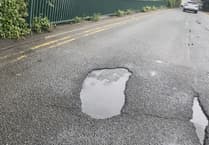Most of us tend to dress for the weather. In this case, it means wrapping up with a hat, gloves, scarf, a big winter coat and appropriate shoes.
So it makes sense to use the same concept when out on the road and adapt your driving behaviour depending on the weather conditions.
IAM RoadSmart’s head of driving and riding standards, Richard Gladman, is offering advice to motorists to better cope with driving on road surfaces that are covered in frost, ice or snow.
• If the weather conditions are severe in your area, you should take notice of police advice and simply not travel.
However, in exceptional circumstances if you must go out then make sure you drive safely with extra caution on icy roads.
• At least triple your stopping distance and approach every junction expecting to stop well before the stop or give way line - it can take up to ten times as long to stop according to Highway Code advice.
Every steering, acceleration or braking input should be as smooth and gentle as possible and select second gear when you pull away in icy conditions. Less torque will help prevent wheel spin
• Salt will often make the windscreen, headlights, number plate and rear parts of your car very dirty. Cars without headlamp washers, for example, will lose an estimated 40 per cent of luminosity and possibly all their focus in about 20 miles on a damp, gritted motorway.
When travelling long distances it is advised that you stop regularly at service stations to clean your windscreen and headlights with a clean cloth. Or keep a filled bottle of water in the car boot to give your lights, windows and mirrors a quick wash over – a handy investment is to top up your windscreen washer reservoir when needed too.
• Never ignore any warning lights. If one appears, get it checked out sooner rather than later. Being stuck on the side of the road is never good, but breaking down in freezing conditions is a high risk situation
• Always carry a winter driving kit including an ice scraper, de-icer, blanket, torch, shovel, something to eat and a fully charged mobile phone.
• When driving on a busy road avoid overtaking a gritting lorry, as the road ahead may not be treated yet. If you have any doubt, don’t risk it. And make sure to never overtake a snow plough in heavy snow conditions.
• While roads may be gritted to give you better traction, some areas may not be completely treated which can leave ice patches exposed. You should therefore drive at a steady pace, ensuring the safety of you and your passengers.
On the roads you use regularly, watch out for water running across the carriageway as this can wash away salt
• It’s important that you keep your car clean as the salt in grit can cause corrosion to any exposed parts. Ensure that you thoroughly wash the underneath of your car when you can to stop salt from settling.
• Don’t forget to wash/rinse alloy wheels too; the smallest scratch can quickly become a large corroded area.
• Just because the winter sun is out does not mean the roads might not be icy. Micro climates of icy patches will linger in areas that are still covered by shade.




